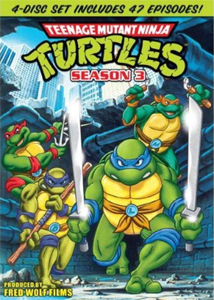“Teenage Mutant Ninja Turtles” Season 3’s (1989) concluding batch (episodes 38-47) features imaginative notions, the return of Baxter-Fly and the Neutrinos, and a suitably “Big” – if rather expected — finale featuring the Technodrome’s return to the surface (finally!).
But first – cue record scratch – we get three (!) more appearances of Zach, who was introduced back in “The Fifth Turtle.” Liked by some viewers, loathed by others, the 14-year-old Turtle fan seems to be at the center of a writer’s-room push to remember that tweens and young teens are the target audience.
Attack of big Zach
In Francis Moss’ “The Great Boldini” (38) and David Wise’s “The Missing Map” (39), Zach hangs out with the Turtles in their lair, first bringing his friend Caitlyn, then his brother Walt. This notion that someone new is tight with the Turtles clashes with the conceit in some other episodes wherein the Turtles believe they must remain secretive.

“Teenage Mutant Ninja Turtles” Season 3, episodes 38-47 (1989)
Syndicated
Episodes: “The Great Boldini” (38), “The Missing Map” (39), “The Gang’s All Here” (40), “The Grybyx” (41), “Mister Ogg Goes to Town” (42), “Shredderville” (43), “Bye, Bye, Fly” (44), “The Big Rip-Off” (45), “The Big Break-In” (46), “The Big Blow Out” (47)
Producer: Fred Wolf
Writers: Francis Moss (38, 43), David Wise (39, 42, 44, 46, 47), James A. Davis (40), Michael Reaves (41, 45)
At least in “The Missing Map,” Michaelangelo walks Zach and Walt through a convoluted path back to the manhole to their house; the Turtles don’t want the lair to be easy to find. In another logistical point, we see a bird-shaped drone that Krang and Shredder use to spy on the Turtles, sending images back to the Technodrome viewscreen. Finally, we find out how the bad guys pull off that trick. It’s unknown, though, why the drones can’t follow Team Green to their lair.
If you’re not sick of the gag of mobster Don Turtelli using feathers to torture information out of captives (Zach and Caitlyn in this case), “Boldini” is fun – plus, the Rat King guest-stars, always a good thing. “The Missing Map” is a heavy-handed lesson for Walt, who learns it’s wrong to steal from the Turtles and to envy his brother.
It features an unfortunate trick of Wise’s – although one that I now accept as part of “TMNT’s” fabric: The writer invents a nonsensical maguffin to launch the plot. In this case, actually, he uses two: Walt steals both a map to the Turtles’ lair and a document proving that Oroku Saki’s wrongly got Hamato Yoshi kicked out of the Foot Clan.
In the first case, why would the Turtles keep that map? In the second, how would such a document exist? Did a witness to Saki’s treachery document what he saw? If so, why does Splinter have the document and not the Foot Clan itself?

Taking a flyer at big ideas
Overthinking will drive you crazy – or at least get you off-point – when it comes to “TMNT.” “The Gang’s All Here” (40) seems to promise a reunion with Bebop and Rocksteady’s old gang, but it doesn’t – unless this is a gang that predates the bunch from “Turtle Tracks.”
James A. Davis’ only episode finds Michaelangelo turning human as per Shredder’s latest retro-mutagen – and while this doesn’t make sense (he should turn into a regular turtle, right?) – it is interesting to see Mikey as a 15-year-old human.
The teen emphasis continues with “The Grybyx” (41), wherein Neutrino teen Kala’s titular telekinetic pet gets loose. For a Michael Reaves joint, this is a rather rote exercise. He falls back on an Eighties movie riff – “Gremlins” in this case, as the cute grybyx turns into a monster when he eats Earth food – and delivers the expected flirtations between Mikey and Kala. But it does feature a Shredder line I’ve always loved, after he gets thrown into an ice-cream truck: “I hate grybyxes.”
Wise’s “Mister Ogg Goes to Town” (42) is a popular pick for worst episode of the series, but it’s no worse than mediocre. A magic-using leprechaun from Dimension Z talks like Pee Wee Herman and eats ceramics (!) – to the annoyance of Shredder, who we learn collects antique vases (!). Almost achieving a “Camera Bugged” level of imagination via Ogg’s visual manipulations, “Mister Ogg” did not inspire a Playmates action figure, and probably won’t even get a NECA action figure, but the hatred is overstated.
But if Shredder’s going to gaslight a villain into hating the Turtles, we’d rather it be Baxter, who completes his Baxter-Fly trilogy (although he will be back for some CBS episodes) with Wise’s “Bye, Bye, Fly” (44). Not as good as “Return of the Fly,” it’s nonetheless notable for being one of the episodes made into Series II trading cards (along with “Usagi Yojimbo”). It finds Mikey being transformed yet again – into a gerbil this time – by another of Wise’s out-of-nowhere inventions, a muta-zoo ray gun.
A big twist, and a big finale
Despite competing against lead writer Wise and eventual legend Reaves, Moss delivers the gem among these 10 episodes with “Shredderville” (43). It’s the third Zach appearance in this batch – although he’s technically an alterna-Zach who hates mutants. So does everyone else in this nightmare reality where Shredder rules New York City. Yep, “TMNT” got to the “What if the hero(es) didn’t exist?” installment nine years before “Buffy’s” “The Wish.”
This is a compelling episode, especially for the target audience, with strong backgrounds and surprising concepts like April and Irma being serving girls for a human Bebop and Rocksteady. Under Shredder’s dictatorship, the city falls into dystopian ruin.
Moss achieves a sense of mystery even though we know Shredder is behind it (“Corporate Raiders from Dimension X” also pulled off this trick). It’s neat to see that even Krang hates this state of affairs, and that Shredder has grown to loathe the responsibilities he claimed for himself. This is sharp stuff for a kids’ cartoon.
The season wraps as we know it must with the Technodrome finally getting power and returning to the surface in the “Big” trilogy – Reaves’ “The Big Rip-Off” (45) and Wise’s “The Big Break-In” (46) and “The Big Blow-Out” (47).
While the animation isn’t great, there is a certain grandeur to the Technodrome rolling across the land – all the way to Mount Rushmore for one part of the scheme – and the animators come up with evocative nighttime background plates for the Big Apple.
The sheer size of the battle machine (the dimensions of which admittedly fluctuate depending on the episode) is emphasized when the Turtles and Splinter get inside and more of that “Star Wars”-esque action – also seen in the Season 1 and 2 finales – ensues. Shredder and Splinter face off on a catwalk above a gaping pit straight out of Cloud City.
End of the biggest season
And so we arrive at the end of our 47-episode journey, one in which the Turtles don’t exactly grow … although they do change into humans and gerbils, and they are in danger of shrinking – again. And I guess they do literally grow into giant balloons in “Michaelangelo’s Birthday.”
The voice acting is generally excellent, but it’s a shame the animation couldn’t be better. Still, releasing 47 episodes in a little over two months to close out the Eighties is a remarkable achievement in sheer quantity.
Season 3 is at the heart of the period when “TMNT” was a fresh discovery for kids, who found the Turtles cool before they were cool. Season 4 will be post-movie, when the Turtles move over to CBS Saturday mornings and into the mainstream.

